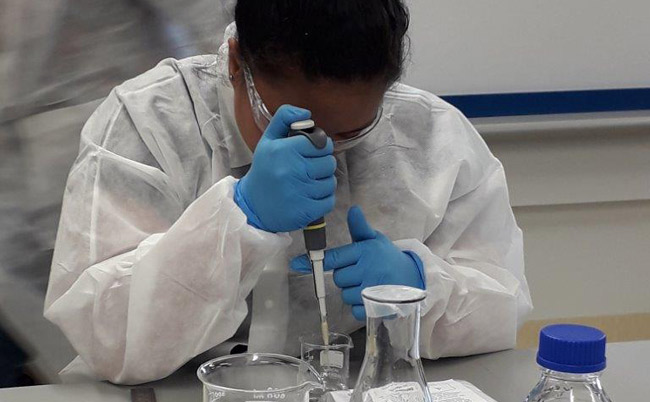Tuesday 16 April 2019 11:06am

A student from a kura kaupapa Māori (Māori language immersion school) has a go at pipetting at the University of Otago, Wellington.
From dissecting a sheep’s heart and lungs to examining the microbial properties of manuka honey, a ground breaking initiative at the University of Otago, Wellington, has a no holds barred attitude to hosting students from kura kaupapa Māori (Māori language immersion schools).
The students visit the University to explore the overlapping worlds of a Western science paradigm alongside the Māori world view of science (pūtaiao te ao Māori), having a lot of fun along the way.
The project began as a one-off event five years ago. Since then, 130 students from kura kaupapa Māori in the greater Wellington region have visited – and revisited - the University for a day-long programme of hands-on science and learning in te reo Māori and English.
The project is run in partnership with Kia Ora Hauora (a national initiative which supports Māori into health careers) and kura kaupapa Māori in the greater Wellington region. It is spearheaded by Dr Sara Filoche, a senior lecturer in the Department of Obstetrics, Gynaecology and Women’s Health and the Department of Pathology and Molecular Medicine, and Shirley Simmonds, a kaupapa Māori health researcher.
"I am learning alongside the kids. Not only in areas of science that I am new to, such as soil biology but for me to learn te reo Māori and about pūtaiao is one of the biggest rewards for me."
The project has recently been awarded a $150,000 Unlocking Curious Minds grant. Dr Filoche says this will enable the University to expand the programme to more kura in the wider region – and to continue to support those already involved. This year students will travel to the University from as far afield as Benneydale in the King Country.
“There is nothing quite like when we open up the double doors in the student pathology lab, and we have set up the experiments and then seeing them come in and getting all excited about the idea of coming in to do science. The lab coat plays a big part in that. But it is more than that too - we are exploring the science between and within two worldviews,” Dr Filoche says.
The programme for the day is designed in consultation with each kura, to ensure it meets the aims and kaupapa of the kura, and to align with the NCEA syllabus where necessary. It usually involves three or four practical experiments.
“One of the kura from Ōtaki were keen to look at the antimicrobial properties of kawakawa leaves and so they came in to look at whether it was true that when kawakawa leaves have more holes they have stronger antibacterial properties.”
And while there will always be students who are keen to blow stuff up in the lab , the sessions have a more ambitious goal – to get the students thinking as science citizens.
“Where we are looking at DNA that is taken from genetic tests, for example from personal genome services, we discuss how the DNA can become the commodity and who has access to this health information, and how it can be used, so it is getting the kids thinking about these bigger issues that will affect them.
“These are societal issues, which everybody needs to be able to have a voice on.”
Dr Filoche always runs the experiments beforehand to make sure they work. Even so, it is always a case of expect the unexpected.
“Once we experimented with fluorescence. It was amazing and very simple; we blackened out the lab, we dismantled millions of highlighter pens, dropped the liquid from inside the highlighter pens into water, and using UV blue light you just get the shine, the fluorescence really pops. It was absolutely fabulous.
“One of the things I hadn’t anticipated was quite how messy it was going to be and also that the students would draw on themselves with the pens. We had a white pen that only showed up under blue light and I found them drawing on each others’ faces, and so I had to say, ‘promise me you won’t hit blue light because it is going to take two or three weeks to come off’. So I hadn’t quite anticipated that, but at the same time, it was quite funny.”
"Getting to know the students as they come in each time is really special and I feel very privileged to form a little bit of their learning journey. It’s quite magic, it really is."
Dr Filoche sees the sessions as mutual learning exercises, and often responds to students questions about how an experiment will turn out, by answering, ‘I don’t know, give it a go and find out’, giving the budding scientists the chance to find out for themselves.
“I am learning alongside the kids. Not only in areas of science that I am new to, such as soil biology but for me to learn te reo Māori and about pūtaiao is one of the biggest rewards for me.”
She says the programme is a team effort and involves colleagues from Te Rōpū Rangahau Hauora a Eru Pōmare – Associate Professor Bridget Robson and Ruruhira Rameka - as well as from the Department of Pathology and Molecular Medicine – Dr Michelle Thunders and Jane Anderson.
“We’ve had support from the Dean, Professor Sunny Collings, right from the beginning for this programme, so that has been instrumental and the Head of the Department of Pathology and Molecular Medicine, Associate Professor Diane Kenwright, is incredibly supportive and of course the students themselves.
“Getting to know the students as they come in each time is really special and I feel very privileged to form a little bit of their learning journey. It’s quite magic, it really is,” Dr Filoche says.
